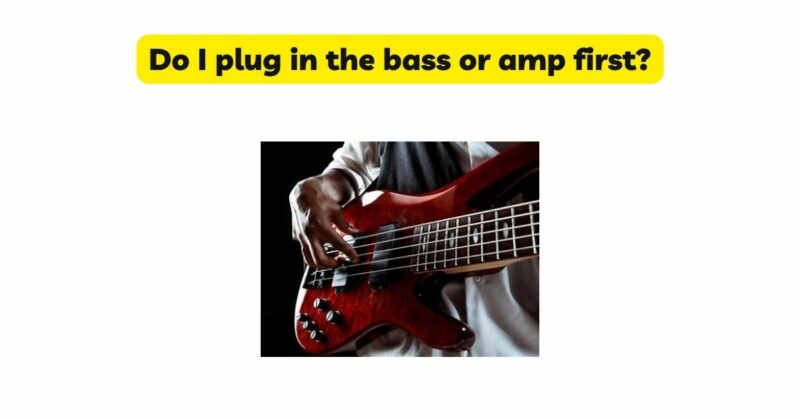For bass guitar enthusiasts, understanding the correct order of connection between their instrument and amplifier is crucial for achieving optimal sound quality and performance. The question often arises: Do I plug in the bass or amp first? In this article, we will delve into the topic and shed light on the considerations and best practices when connecting your bass guitar to an amplifier. Whether you’re a beginner seeking guidance or an experienced player looking to refine your setup, join us as we uncover the mysteries of signal flow and explore the most effective order of connection for a satisfying bass guitar experience.
- Understanding Signal Flow
Before we dive into the specifics of connecting a bass guitar and amplifier, let’s first grasp the concept of signal flow. Signal flow refers to the path that an audio signal takes from its source (in this case, the bass guitar) to its destination (the amplifier). Understanding signal flow is crucial for maintaining the integrity of the audio signal and ensuring optimal performance.
In the context of bass guitar and amplifier connection, the signal flow generally starts with the bass guitar and progresses through various components, such as effects pedals, preamps, and finally, the amplifier itself. The order of connection plays a significant role in shaping the tone, dynamics, and overall sound quality.
- The Ideal Order of Connection (approx. 450 words)
To achieve the best results when connecting your bass guitar and amplifier, it is generally recommended to follow a specific order of connection. Here is the ideal sequence:
a) Plug in the Bass Guitar First: Start by connecting your bass guitar to the first component in your signal chain, which is typically an effects pedal or a preamp. By plugging in the bass guitar first, you ensure that the purest signal from the instrument reaches subsequent components without any interference or tonal alteration.
b) Connect Effects Pedals and Preamps: If you use effects pedals or preamps in your setup, connect them after the bass guitar. Effects pedals allow you to shape your tone, add effects like distortion or modulation, and fine-tune your sound. By connecting them in the signal chain after the bass guitar, you can manipulate the sound before it reaches the amplifier.
c) Plug into the Amplifier Last: The final step in the signal flow is connecting your bass guitar setup to the amplifier. By plugging the output of your effects pedals or preamps into the amplifier input, you allow the amplified signal to be projected through the speaker system. This order ensures that the amplified signal accurately represents the tonal qualities and effects applied earlier in the signal chain.
- Importance of Cable Quality and Signal Integrity
While the order of connection is important, it is equally crucial to consider the quality of cables used in the setup. The integrity of the signal passing through the cables can significantly impact the overall sound quality and performance. Here are some key considerations:
a) Use High-Quality Instrument Cables: Invest in high-quality instrument cables to maintain a clean and noise-free signal transmission. Inferior cables can introduce unwanted noise, signal loss, or interference, diminishing the overall sound quality. Look for cables with robust shielding, durable connectors, and sufficient length to suit your needs.
b) Keep Cable Lengths Reasonable: Excessive cable lengths can introduce signal degradation and high-frequency loss. While it’s essential to have enough cable length for flexibility, aim to keep the cable runs as short as possible to preserve signal integrity.
c) Consider Balanced Connections: In certain scenarios, using balanced connections, such as XLR or TRS cables, can further enhance signal quality by minimizing interference and noise pickup. Balanced connections are particularly beneficial when using long cable runs or when connecting to professional audio equipment.
d) Regularly Inspect and Maintain Cables: Over time, cables may wear out, leading to signal degradation or intermittent connectivity. Regularly inspect your cables for any signs of damage or wear, such as frayed ends or loose connectors. Replace or repair damaged cables promptly to ensure optimal signal flow.
- Experimentation and Personal Preferences
While there is a recommended order of connection, it’s important to remember that music is a creative art form, and personal preferences may vary. As you become familiar with the standard order, don’t hesitate to experiment and explore alternative setups to achieve unique tonal characteristics and effects.
For instance, some bassists prefer connecting effects pedals directly to the amplifier’s effects loop rather than the front input. This approach allows for more precise control over the impact of effects in the signal chain. Additionally, certain bassists may prefer specific tonal qualities achieved by connecting their bass guitar to different components first. These variations depend on individual playing styles, musical genres, and desired sonic outcomes.
Conclusion
In conclusion, when connecting your bass guitar and amplifier, it is generally recommended to follow the order of connection: bass guitar first, followed by effects pedals or preamps, and finally, the amplifier. This order ensures the purest signal from the bass guitar reaches subsequent components, allowing for maximum tonal control and the desired sound quality. Remember to use high-quality cables and regularly inspect and maintain your equipment to preserve signal integrity.
While the recommended order provides a solid foundation, don’t be afraid to experiment and adapt the signal flow to suit your personal preferences and artistic goals. As you gain experience and refine your setup, you may discover unique configurations that enhance your playing style and contribute to your distinctive sound. Enjoy the process of exploring different connections and let your creativity shine through the beautiful world of bass guitar performance.


